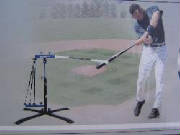|
Drill # 2
-----------------------------
"Back-side Barrier Drill"
-----------------------------
- This drill is used to shorten-up a hitters swing.
- If the batter is too long to the ball or has that A to B to C swing that is considered a slow-pitch softball swing, drills
can be used to make the hitter shorten up.
- The batter sets up with his hands 8 to 10 inches from barrier (a wall or fence) with the barrier behind
the batter. The batter should assume a position putting the barrier parallel to the hitter back foot.
- If the batter casts the hands backwards or loops the bat, he will hit the fence or barrier.

Drill #3
-----------------------------
"Two Ball Soft Toss"
-----------------------------
- The hitter learns to concentrate on seeing the ball and keep the hands and weight
back.
- The coach tosses two balls. The coach calls top or bottom after the balls are
releasd. The hitter hits the called ball into the fence or screen.
- This drill can be done from different locations.
- The coach should also fake toss and change the release points as well as vary
the speed of the balls.

Drill #4
-----------------------------
"Bunt Pepper Drill"
-----------------------------
"An offensive and defensive drill."
Everybody
knows that you must "hit to win"! However, I believe that one of the most often neglected phases of the game is the "short
game". Of course we would rather "green light" all hitters. But in reality sooner of later your team's ability to bunt or
inability to bunt will affect the outcome of a game. Execution of the bunt takes proper instruction and regular practice.
"Bunt Pepper" is a great drill to use as a warm-up before practice. The drill is performed with 4 players in
a group. Each player bunts 5 and then rotates. Four players field the bunts and throw a strike to the bunter. The drill incorporates
many teaching fundamentals. The bunter learns to see the ball, to have bat control, to use correct bat angle, and to use the
different types of bunts. The drill would be set up as below:
(players)_____a
b c d_____
(players)________x________
The bunter bunts 5 times and then goes to defense. The last bunt is a drag or push bunt. The bunter then lays
the bat down and assumes the position of the "a" player that moves to the "b" spot. The "d" player comes to the bunt spot.
This drill is a fast paced drill. We performed it daily for from 5 to 10 minutes.
Remember to emphasize the following:
1. The bunter will use the "square", "pivot"
and "drag/push" techniques.
2. The ball must be bunted downward. A ball caught in the air by a defender means 10 pushups.
3. The defenders use this drill to perfect their footwork. They are now allowed to throw a pitch to the bunter without
first turning their body and feet to the proper throwing position.
4. You may want to incorporate other skills into the
drill such as having your middle infielders use an underhanded "stiff wrist" double play feed as their throwing method. Such
changes keep the interest level up and adds valuable repetition of basic skills.

Drill #5
-----------------------------
"Off-the-wall" Drill
-----------------------------
- This is a great ofF season skill building activity. It develops both offensive and defensive skills.
- The game is played with 3 players on a team. On defense, one pitches and two play defense. The object of the game is to
be the first team to score 21. You score by hitting a linedrive or ball in the air that hits the wall in a designated or target
area. The target area is normally a 6x12 rectangle that is attached to the wall or fence. The target may be larger if space
so allows.
The rules for the game are as follows:
- Each team gets three outs per inning. Outs are hit balls caught before they hit the wall or floor.
- Foul tips, foul balls, and swing without contact are outs. Each players gets one swing of the bat.
- Something must happen, if the ball is a strike. The batter decides if a ball is a strike.
- Ground balls are not outs. They serve to keep the inning alive. You do not get a run for ground balls.
- Flyballs that go above the target are outs.
- Balls may be batted down by defenders to prevent a score. However, batted balls that touch the target before they touch
the floor are scored as a run.
- The winning team must win by two.
- A tournament bracket is drawn and teams play for the championship.
- Coaches and parents are encouraged to play on teams. Each team may use only one bat.
- The bat never touches the ground or floor until the inning is over.

Drill #6
-----------------------------
"Streak Drill"
- The machine should be set at a height suitable for all players participating in the drill for that
day.
- The machine is set with a one-band setting that allows it to rotate multiple times on contact.
- The players compete against each other.
- In the drill the goal is to make good contact as many times as one can without fouling out.
- Good contact is a swing and contact that makes the machine rotate at least once.
- The hitter that has the longest streak that day is the champ.

|

